I’ll never forget the magical day last summer when I spotted a flash of electric blue during a hike in Yosemite. That moment stopped me in my tracks and sparked my obsession with California’s blue birds.
From coastal cliffs to mountain meadows, the Golden State is home to a dazzling collection of blue-feathered beauties that paint the landscape with flashes of sky.
Grab your binoculars and join me on this colorful journey through California’s most gorgeous blue birds!
1. Indigo Bunting
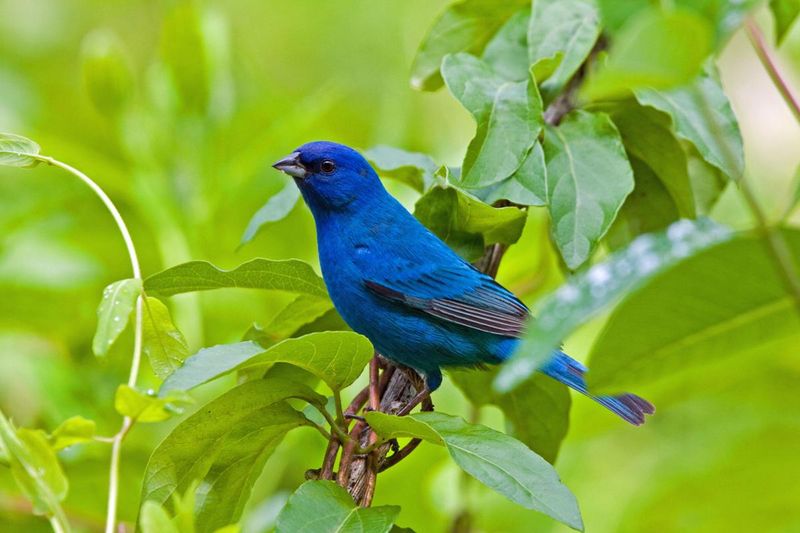
Electric blue doesn’t begin to describe the male Indigo Bunting’s brilliant plumage. These small songbirds look like fragments of sky come to life, especially when sunlight hits their feathers just right. What appears solid blue actually contains no blue pigment at all – it’s an optical illusion created by light refraction!
Migrating to California in spring, these vocal performers sing their hearts out from dawn till dusk. The females, dressed in subtle brown, let their flashy partners do all the showing off.
Listen for their distinctive double-note chirps while hiking along woodland edges. These tiny blue marvels feast primarily on insects during breeding season and switch to seeds in fall.
2. Tree Swallow
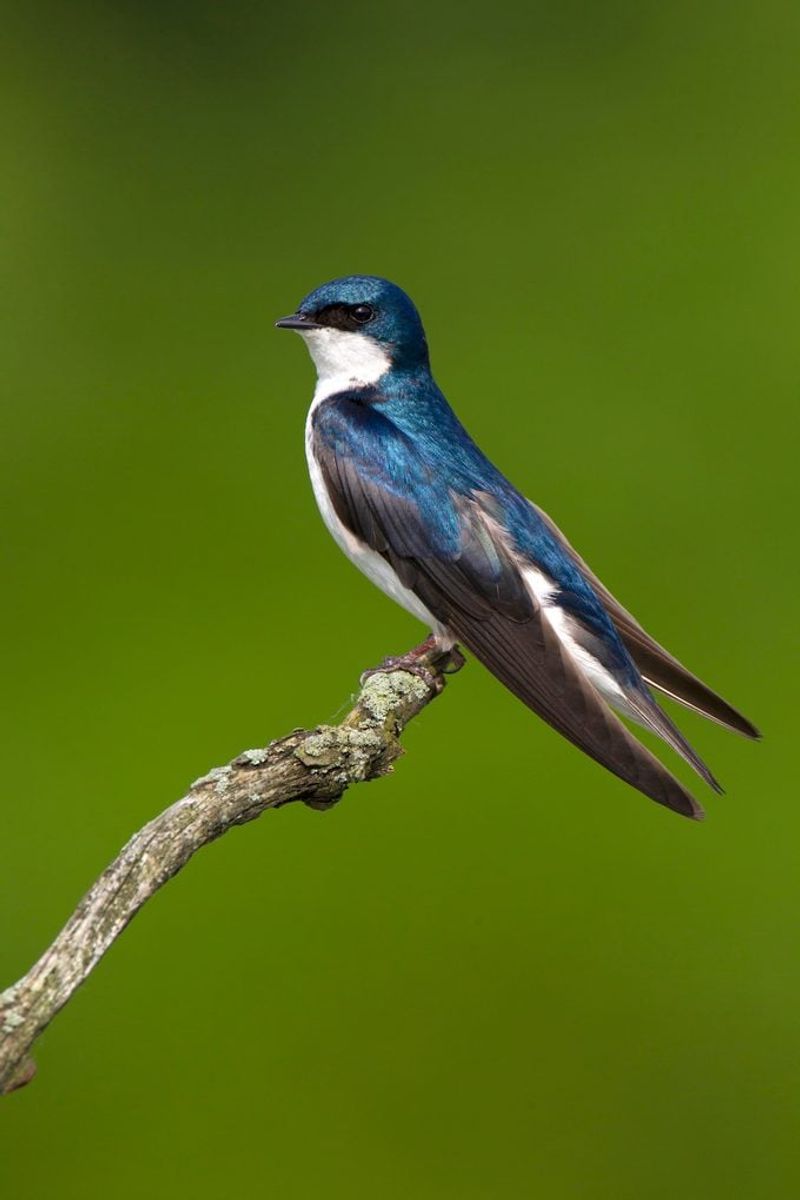
With shimmering blue-green backs and graceful aerial moves, Tree Swallows transform California’s skies into their own high-flying playground. Their aerial ballet isn’t just for show – these graceful flyers catch nearly all their insect meals mid-flight, snatching mosquitoes and flies with impressive precision.
Unlike many migratory birds, some Tree Swallows stick around California year-round, especially near coastal areas and wetlands. Their pristine white undersides contrast beautifully with that glossy blue topcoat, creating a striking two-tone effect.
Cavity nesters by nature, they’ve adapted well to human presence by readily accepting nest boxes. Watch for them skimming over lakes and marshes, occasionally dipping to take a drink without ever stopping their flight.
3. Purple Martin
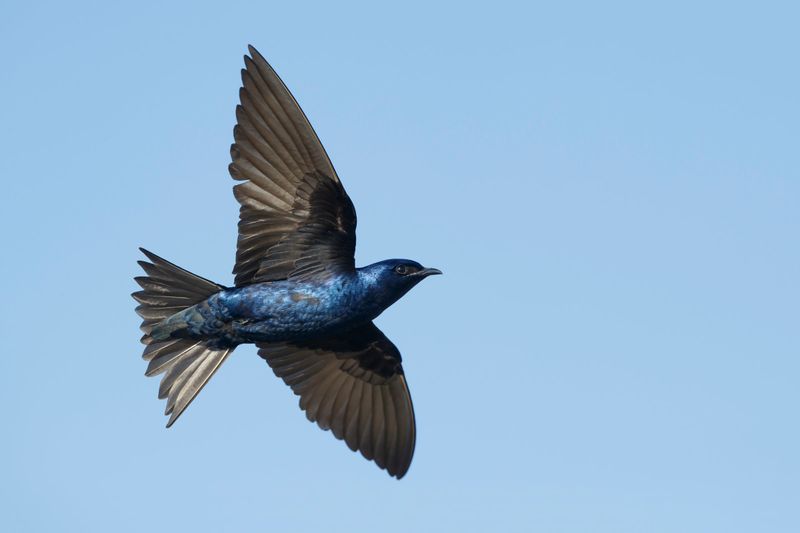
Apartment living isn’t just for humans! Purple Martins, the largest swallows in North America, form bustling colonies in multi-room bird houses throughout California. Males flaunt deep purple-blue plumage that shimmers in flight, while females have a more subdued grayish underside with hints of purple.
These chatty neighbors produce a pleasant, gurgling song that’s music to gardeners’ ears. A single Purple Martin can eat thousands of mosquitoes daily, making them natural pest controllers.
Completely dependent on human-provided housing east of the Rockies, California’s western populations still nest in natural cavities. Their agile flight patterns and sociable nature have made them beloved backyard visitors for centuries – Native Americans hung hollow gourds to attract these beneficial birds long before European settlement.
4. California Scrub-Jay
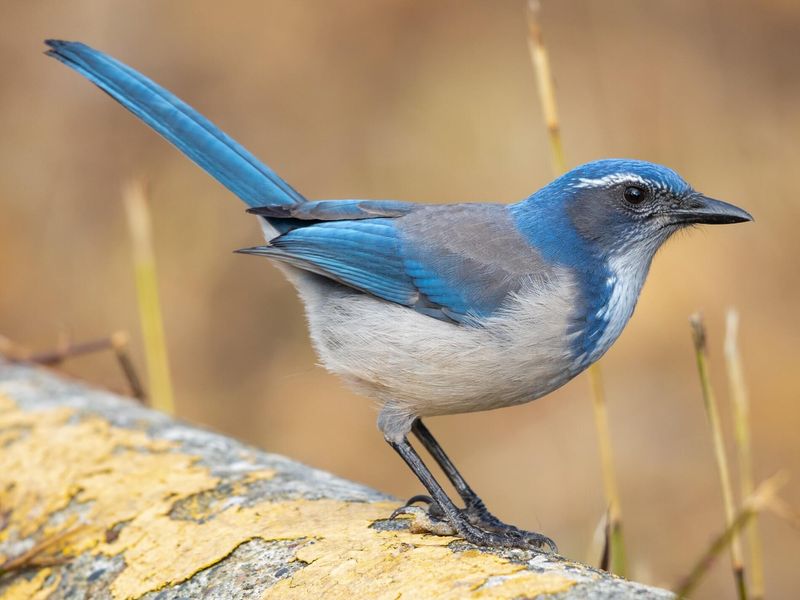
Bold, brash, and unapologetically blue – California Scrub-Jays are the state’s feathered tricksters. Sporting brilliant azure upper parts with a gray-brown back and a distinctive white throat, these jays aren’t afraid to make their presence known with harsh, scolding calls that echo through oak woodlands.
Memory champions of the bird world, they can remember thousands of hiding spots where they’ve cached acorns and seeds. This remarkable spatial recall helps them survive winter when food becomes scarce.
Fiercely territorial year-round, a mated pair will defend their turf against all intruders. Watch them hop confidently across your yard or picnic table – these intelligent birds quickly learn where food might appear and aren’t shy about investigating human activities.
5. Western Bluebird
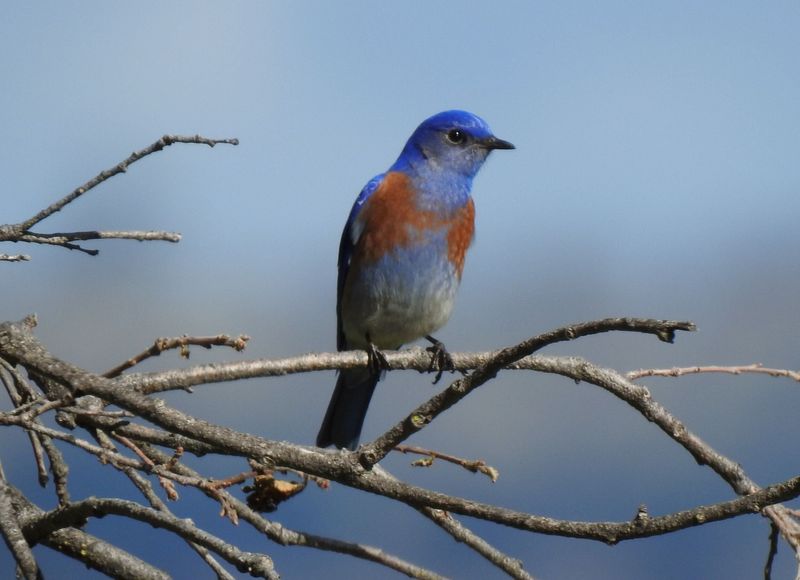
The Western Bluebird captures the colors of a sunset in feathered form. Males display a heavenly cobalt blue head and wings complemented by a rust-orange breast that looks like they’ve dipped their chest in California’s famous golden poppies. Females wear more subdued versions of the same palette.
Morning hikers in California’s open woodlands might spot these medium-sized thrushes perched on fence posts or low branches, scanning the ground for insects. Their gentle warbling songs add a sweet soundtrack to dawn walks.
Conservation success stories don’t get much better than this – Western Bluebird populations rebounded significantly thanks to nest box programs throughout the state. Their habit of hovering briefly before dropping onto prey makes them fascinating to watch during their hunt for beetles, caterpillars, and grasshoppers.
6. Steller’s Jay
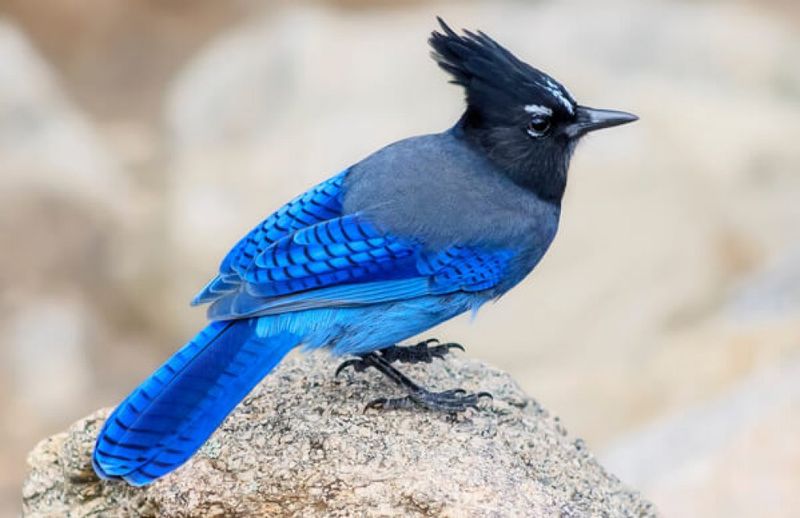
Punk rock meets royalty in the Steller’s Jay, with its spiky black crest and deep blue body making it impossible to miss among California’s mountain forests. These noisy forest dwellers aren’t just striking – they’re scary smart, with problem-solving abilities that rival some primates!
Experts at mimicry, they can imitate hawks, cats, squirrels, and even human voices or mechanical sounds. Their raucous calls often alert other forest creatures to potential dangers, earning them the nickname “watchmen of the woods.”
Campground visitors know these bold birds all too well – Steller’s Jays have learned that humans equal food opportunities. Their diet normally consists of nuts, seeds, and small animals, but they won’t hesitate to swoop down and steal your sandwich if you look away even briefly!
7. Lazuli Bunting
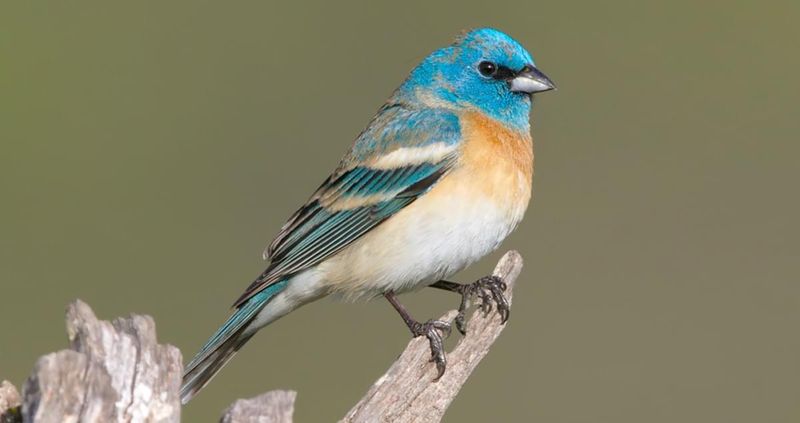
Jewels of the chaparral, male Lazuli Buntings have a turquoise head and back that would make any gemstone jealous. With a rusty-orange breast band and a white belly, their color combination feels almost unreal in its perfection.
Summer visitors to California’s brushy hillsides and stream edges, these small songbirds arrive from Central America in April. Males establish territories by singing complex melodies from exposed perches, each with his own unique arrangement – like feathered composers creating original symphonies.
Females build cup-shaped nests so well-hidden in dense vegetation that finding one feels like winning nature’s lottery. Seeds make up most of their diet, though they supplement with insects during breeding season. Despite their brilliant colors, Lazuli Buntings can vanish into foliage with surprising stealth when startled.
8. Barn Swallow
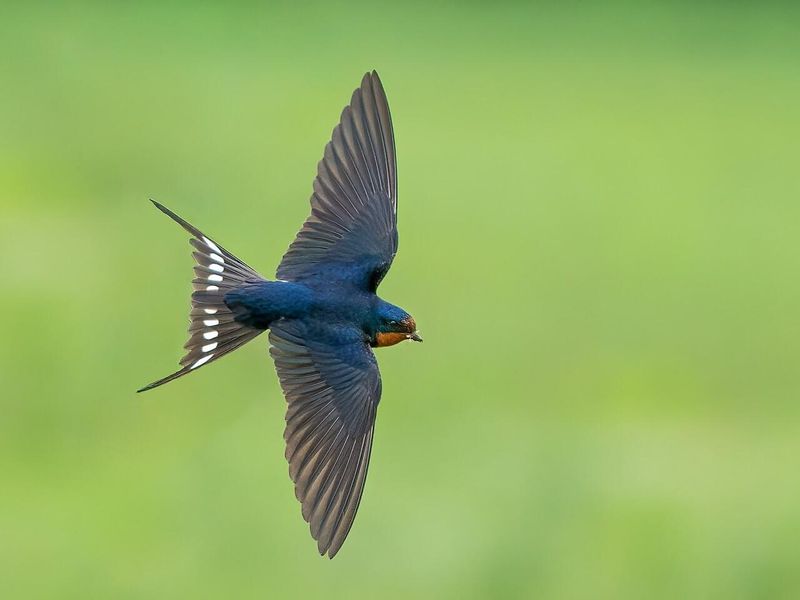
Architects with wings, Barn Swallows create elaborate mud nests that stick like natural cement to buildings and bridges throughout California. Their cobalt-blue backs and rusty-orange underparts flash brilliantly as they perform aerial ballets, twisting and turning with incredible precision.
Those deeply forked tails – their most distinctive feature – act like rudders, allowing hairpin turns at high speeds. Watching them chase insects just inches above water surfaces demonstrates some of nature’s finest flight skills.
Farmers welcome these birds as natural pest control – a single Barn Swallow family can consume over 60,000 flying insects during a nesting season! Despite their name, they existed long before barns, originally nesting on cliff faces and in caves. Their cheerful twittering calls have accompanied human settlements for centuries, making them beloved farmstead companions.
9. Mountain Bluebird
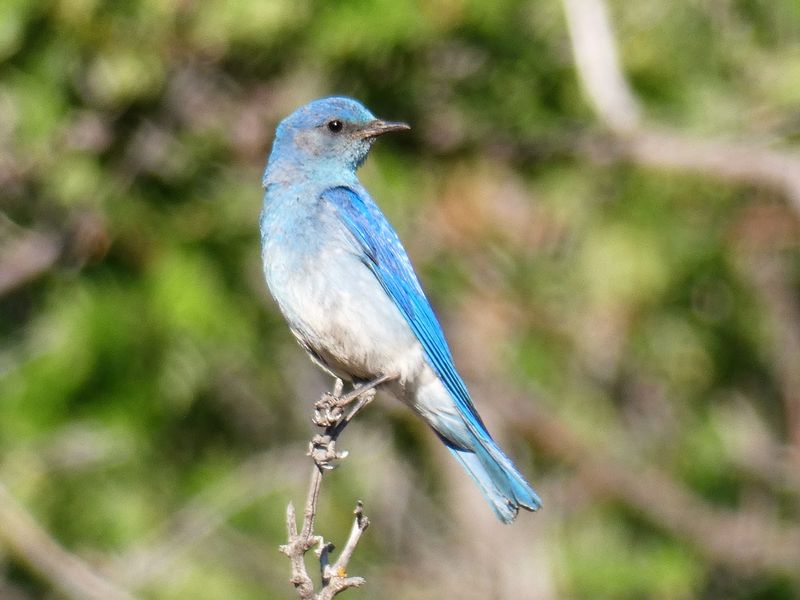
Winter skies take feathered form in the Mountain Bluebird – the most intensely blue of all North American birds. Males display an almost unreal turquoise-blue that seems to glow from within, especially against snowy Sierra Nevada backdrops. Females wear a more subtle gray-blue that’s beautiful in its understated elegance.
California’s high mountain meadows and forest edges host these ethereal birds during summer months. Unlike their Western Bluebird cousins, Mountain Bluebirds lack any rusty coloration, going all-in on various shades of blue.
Hunting techniques set them apart too – they frequently hover like miniature helicopters before diving onto insect prey. Their soft, warbling songs carry across alpine meadows, creating a peaceful soundtrack for hikers. During winter, some descend to lower elevations in California, forming small flocks that bring bits of summer sky to winter landscapes.
10. Pinyon Jay
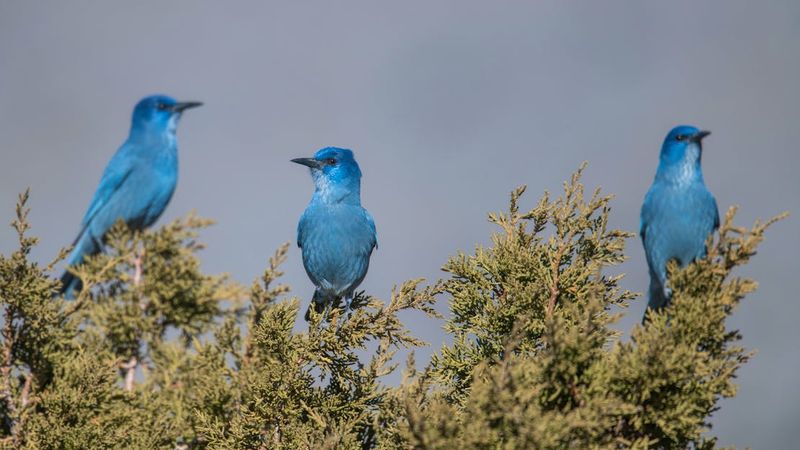
Pinyon Jays are social butterflies of the bird world. They travel in noisy flocks that can number over 100 individuals! Their dusty blue plumage might not win awards for brightness, but their intelligence and complex social structure fascinate ornithologists.
These pine nut specialists have co-evolved with pinyon pines in California’s eastern woodlands. Their remarkable memories allow them to recover thousands of cached seeds months after hiding them. Even more impressive, they can assess which pine cones contain the most nutritious seeds just by looking at them!
Unlike most birds, Pinyon Jays maintain permanent pair bonds and complex family relationships within their flocks. They’re among the few birds that can recognize dozens of individual flock members by sight and sound. Listen for their harsh, nasal calls echoing across California’s pinyon-juniper woodlands – they’re rarely quiet for long.
11. Blue Grosbeak
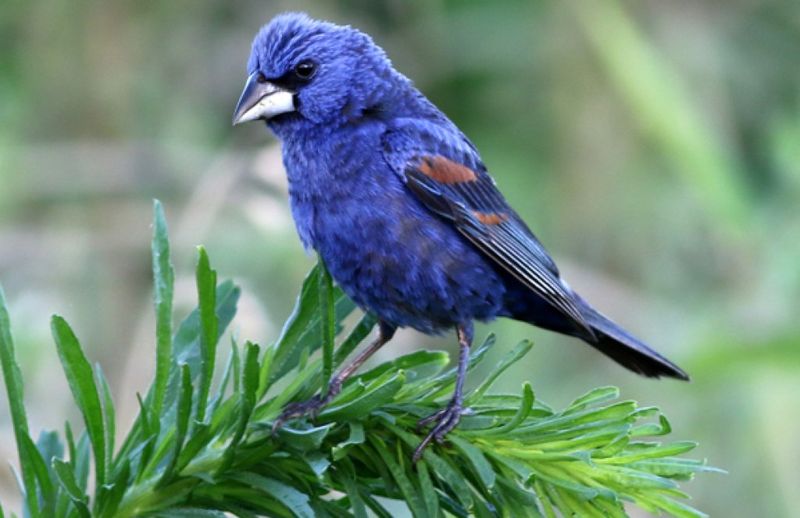
Midnight blue with rusty wing bars, the male Blue Grosbeak brings tropical color to California’s grasslands and field edges. That massive silver conical bill isn’t just for show – it easily cracks the toughest seeds that would defeat smaller finches.
Summer visitors from Central America, these stunning birds arrive in California around May. Males sing a rich, burry warble from exposed perches, often continuing even during the hottest midday hours when other birds fall silent.
Females construct intricate nests using an unusual material – snake skins! They weave shed skins into their cup-shaped homes, possibly to deter predators. Despite their brilliant coloration, Blue Grosbeaks can be surprisingly difficult to spot as they forage in dense brush. Their population has expanded northward in recent decades, possibly due to climate change creating favorable conditions in new areas.
12. Cliff Swallow
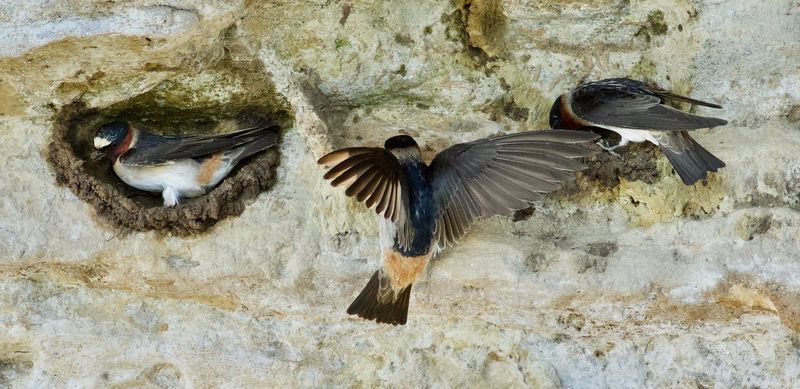
Cliff Swallows are nature’s skilled architects, crafting gourd-shaped mud nests that gather by the hundreds beneath bridges and building eaves throughout California. Their dark blue backs and caps contrast with buff-colored foreheads and throats, creating a distinctive facial pattern unlike any other swallow.
Famous for their annual return to Mission San Juan Capistrano, these social birds have inspired festivals and folklore. Working together, a colony can completely rebuild their mud apartment complex in just a few days, each nest requiring over 1,000 individual mud pellets!
Watch for their graceful flight as they gather insects over California’s waterways and fields. Unlike their Barn Swallow cousins, Cliff Swallows have square rather than forked tails – a helpful identification tip for birdwatchers. Their cheerful twittering creates a constant soundtrack around their bustling colonies during summer months.
13. Island Scrub-Jay
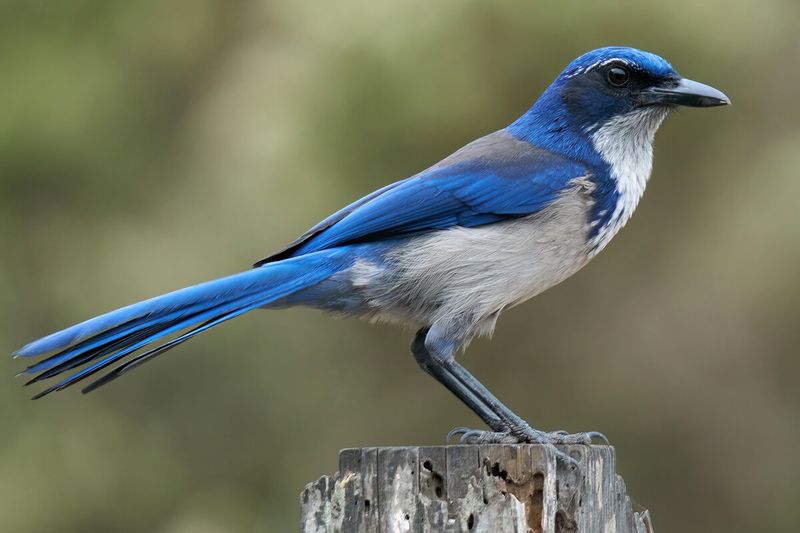
California’s rarest treasure isn’t gold – it’s the Island Scrub-Jay, found nowhere else on Earth except Santa Cruz Island! Larger and more vibrantly blue than their mainland cousins, these island specialists evolved in isolation just 20 miles off the California coast.
With a population of roughly 2,000 birds confined to one small island, they’re among North America’s most range-restricted birds. Their deeper blue coloration and extra-large bill distinguish them from mainland jays – adaptations to their unique island ecosystem.
Acorn obsessed, these birds can cache thousands of oak nuts annually, essentially planting future forests. Their extraordinary spatial memory allows them to recover these hidden treasures months later. Conservation efforts focusing on habitat protection have helped stabilize their numbers, though climate change and wildfire remain serious threats to this California endemic species.
14. Red-flanked Bluetail

Rarity hunters rejoice when a Red-flanked Bluetail appears on California’s coast! These Asian vagrants occasionally wander far off course during migration, creating birding frenzies when they show up. Their electric-blue tails and rusty-orange flanks make identification unmistakable – this bird doesn’t belong here, but what a treat when it arrives!
Normally inhabiting forests across Russia, Korea, Japan and China, these robin-relatives find themselves California celebrities when they appear. Birdwatchers have been known to drive hundreds of miles just for a glimpse of these accidental tourists.
Bluetails typically forage on the ground, flicking their brilliant tails upward with each hop. Their sweet, thin whistles sound exotic to California ears – a melody from distant forests carried across the Pacific. While never common, climate shifts and changing migration patterns might make these stunning vagrants more frequent visitors in coming decades.
15. Purple Finch
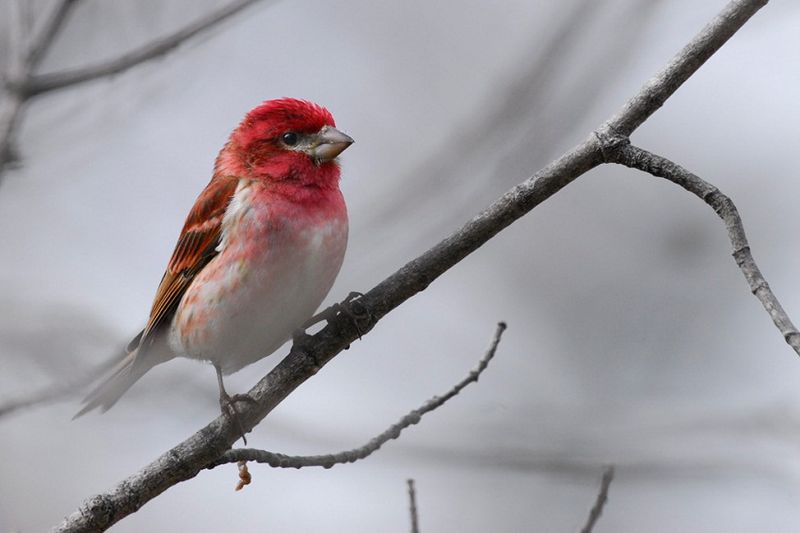
“Dipped in raspberry juice” perfectly describes male Purple Finches, whose rosy-red plumage takes on distinct bluish tones in certain light. These plump little singers bring subtle color to California’s coniferous forests and oak woodlands year-round.
Don’t let the name fool you – there’s nothing purple about them! The “purple” description came from an era when color naming conventions differed from today. Males actually sport a rosy-red wash that’s most concentrated on the head and breast, creating a gradient effect that can appear bluish in shadow.
Their warbling song contains one of the sweetest sounds in California’s forests – a clear, liquid note that rises above their otherwise jumbled melody. Females lack any red coloration but share the bold facial pattern and chunky bill. Watch for them at feeders during winter, where they crack sunflower seeds with impressive efficiency.
16. Violet-green Swallow
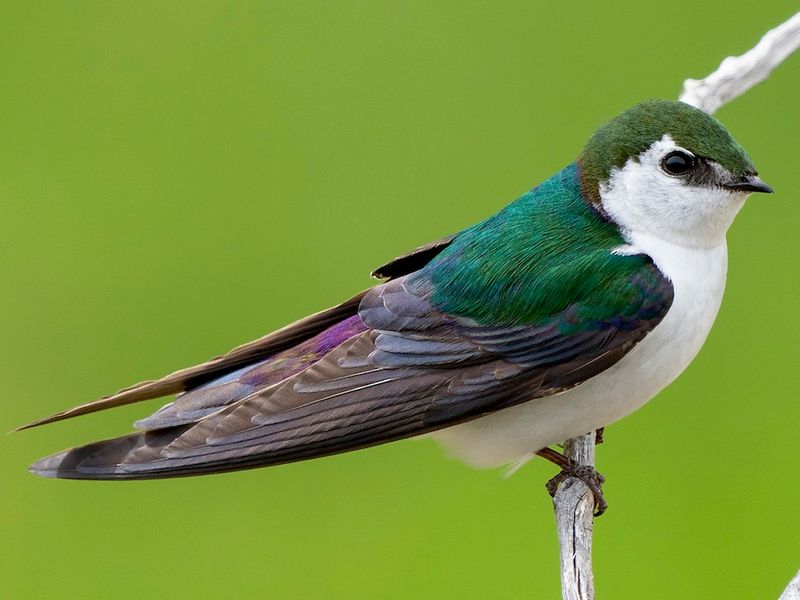
Aerial jewels that outshine even California’s famous sunsets, Violet-green Swallows flash iridescent colors that shift with every twist and turn. Their backs shimmer with an impossible mix of bronze-green and purple-blue that seems to change with each angle of light.
White patches extending up the sides of their rump create the appearance of a saddle, making identification easier even in flight. These agile flyers perform breathtaking aerial acrobatics while hunting flying insects over California’s mountains and valleys.
Cavity nesters by nature, they’ve adapted to human structures and readily accept nest boxes. Unlike their swallow cousins who build mud nests, Violet-greens prefer existing holes in trees or cliffs. Their soft, chittering calls are gentler than other swallows, matching their delicate appearance. Watch for them gathering by the hundreds before fall migration – a swirling kaleidoscope of iridescent color.
17. Belted Kingfisher
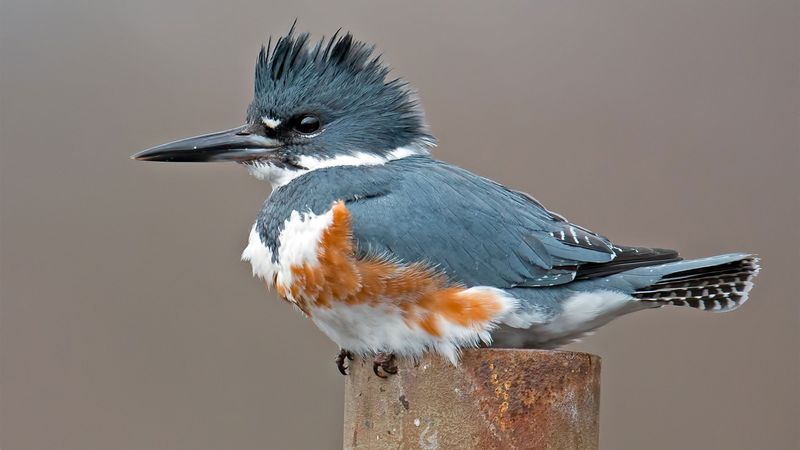
Rattling calls announce the Belted Kingfisher long before you spot its blue-gray mohawk and oversized head. These waterside sentinels patrol California’s lakes, rivers, and coastal areas with military precision, flying back and forth along established routes.
Gender roles flip in kingfisher fashion – females sport a rusty band across their blue-gray breast that males lack, making them more colorful than their partners. This reversal of the usual bird pattern makes them especially interesting to observe.
Masters of the headfirst dive, they plunge from perches or hovering positions with laser focus, disappearing beneath the water’s surface to emerge with wriggling fish. Their nesting habits are equally fascinating – pairs excavate horizontal tunnels up to 8 feet long in earthen banks, creating underground nurseries safe from most predators. Year-round residents in much of California, they add drama to waterways in all seasons.
18. Common Gallinule
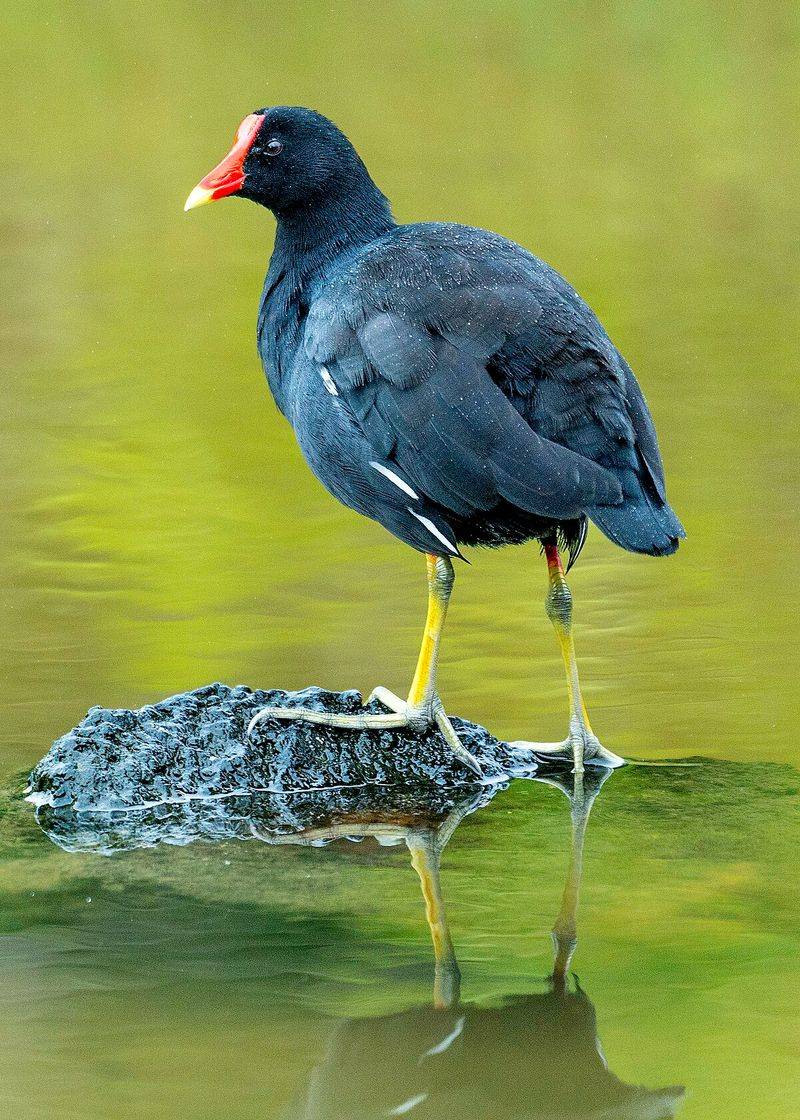
Midnight-blue bodies topped with candy-corn beaks make Common Gallinules instantly recognizable among California’s wetland birds. Formerly called moorhens, these chicken-like marsh dwellers stride across lily pads on their oversized yellow-green feet, somehow distributing their weight to avoid sinking.
Their bodies feature a subtle blue-gray coloration that takes on a more pronounced blue sheen in certain lighting conditions. The brilliant red shield above their beak serves as a status symbol – brighter shields indicate healthier, more dominant birds.
Chicks emerge as tiny black fluffballs with bald red heads, looking like punk-rock ducklings. Surprisingly good swimmers despite not having webbed feet, they dive underwater when threatened, using submerged vegetation as hiding spots. Their vocalizations range from chicken-like clucks to surprising loud squeaks and cackles that echo across California marshlands, especially at dawn and dusk.
19. Blue-gray Gnatcatcher
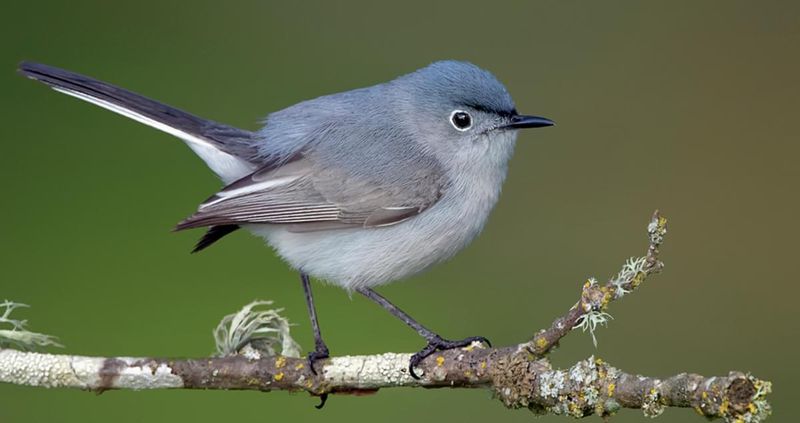
Tinier than your thumb, Blue-gray Gnatcatchers pack personality into a 4-inch frame! These miniature bundles of energy never stop moving, constantly flicking their long black-and-white tails while hunting insects among California’s oak woodlands and chaparral.
Their soft blue-gray upper parts and white underside create a delicate palette that blends perfectly with misty coastal mornings. Black “eyebrows” appear on males during breeding season, giving them a perpetually inquisitive expression.
Nests resemble tiny teacups covered in lichen – architectural masterpieces that perfectly camouflage against tree branches. Their high, thin “spee” calls sound more like insects than birds, causing many hikers to overlook these diminutive dynamos. Despite their small size, they fearlessly chase away birds many times larger that venture too close to their nesting territory. Year-round residents in much of California, they bring constant movement to winter landscapes.
20. Cerulean Warbler
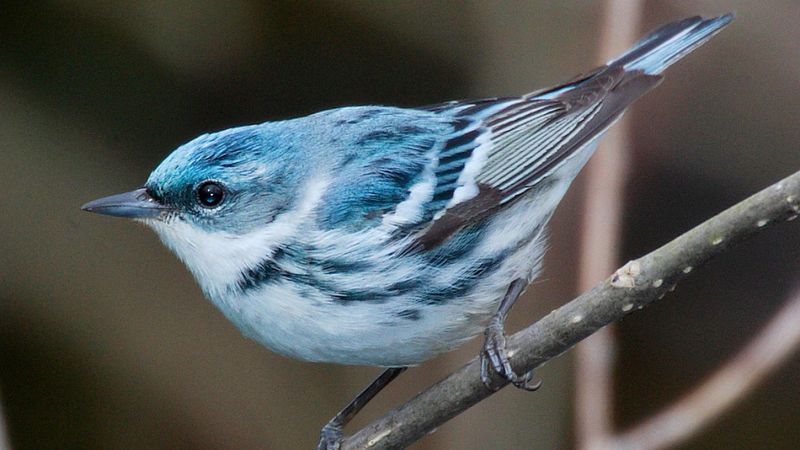
Draped in sky-blue feathers, male Cerulean Warblers represent California’s rarest blue visitor. They occasionally appear during migration, causing excitement among dedicated birdwatchers. Their name perfectly describes their coloration – a soft, cerulean blue that seems to glow against forest greenery.
Canopy specialists, they spend most of their time high in treetops, making neck-craning observation the norm. Delicate necklace-like streaks across the male’s white throat and breast create a distinctive pattern unlike any other warbler.
Sadly, these beautiful birds have experienced one of the steepest population declines of any North American songbird – nearly 70% since the 1960s. Forest fragmentation throughout their range threatens their future. California sightings typically occur along the coast during spring and fall migration, when these tiny travelers make brief appearances during their long-distance journeys between South America and eastern North American breeding grounds.
